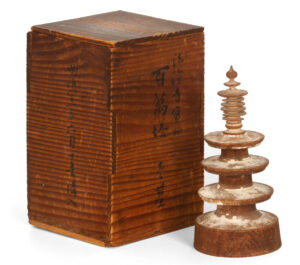Article
HYAKUMANTŌ DHĀRAṆĪ (百万塔陀羅尼): THE EARLIEST RELIABLY DATABLE PRINTED TEXT
DOUGLAS STEWART
The Hyakumantō Dhāraṇī is the earliest printed text to have survived in Eastern or Western cultures that can be verifiably dated, predating the movable type of Gutenberg by some seven centuries.
In the year 764 CE, the Empress Shōtoku (称徳天皇) commissioned one million (hyakuman) miniature wooden pagodas (tō) for distribution to ten major Buddhist temples in Japan. Known collectively as the Hyakumantō (百万塔), each contained a small scroll on rice paper with a Buddhist mantra or prayer (dhāraṇī), which was most likely printed on a bronze tablet – although some scholars suggest wooden blocks were used.
The Mahayana branch of Buddhism had reached China from India towards the end of the Han period, around 150 CE. It spread from China to Japan in the 6th century CE, where it quickly established itself as the primary form of Buddhism. In Mahayana devotional practice a dhāraṇī is a charm or prayer. Each of the Hyakumantō contained a dhāraṇī from the body of texts known in Sanskrit as the Vimalasuddhaprabhasa mahadharani sutra, and in Japanese as Mukujōkō daidarani kyō (無垢淨光大陀羅尼經). The sutra had been translated into Chinese by the Central Asian monk Mituoxian between 680 and 704 CE, and was one of the key sutras of Empress Shōtoku’s period. Chinese was the principal language of worship, as there was no formal standardisation of written Japanese at this early date; consequently, the dhāraṇī contained in the Hyakumantō were printed in Chinese script. As well as being intended for the expiation of sin and the accumulation of religious merit, the prayers were believed to have apotropaic powers, which meant that each of these diminutive pagodas was in essence a protective talisman to ward off evil spirits. Each of the Hyakumantō contained one of four prayers, known in Japanese as the Kompon, Jishinin, Sorin, and Rokudo. The Hyakumantō Dhāraṇī were dedicated and distributed to the ten major temples in Japan at the time: Sadai-ji, Daian-ji, Shitennô-ji Yakushi-ji, Tôdai-ji, Hôryu-ji, Sûfuku-ji, Kôfuku-ji, Genkô- ji, and Kôfuku-ji, where they were housed in specially constructed halls known as shōtōin.
The earliest record we have of the commission of the Hyakumantō Dhāraṇī is found in the Shoku Nihongi (続日本紀) of 797 CE, a 40-volume work of national history which documents their creation. Although it is questionable whether one million of the Hyakumantō Dhāraṇī were actually made, it would appear certain that at least several hundreds of thousands were – an unprecedented example of mass production in Japan, which came at great personal expense to the Empress. We are certain that a small army of artisans was responsible for their creation: from the evidence provided by a maker’s mark on many of the surviving examples, it has been ascertained that no fewer than 157 artisans were engaged in their production.


There are various theories as to why the Empress of Japan commissioned the Hyakumantō Dhāraṇī. The project commenced in 764 at the conclusion of the Fujiwara no Nakamaro Rebellion (藤原仲麻呂の乱), and continued until the Empress’ death in 770 CE. Her act is formally recorded as a gesture of thanks for the crushing of the rebellion; other sources speculate it was an act of penance stemming from her association with the monk Dōkyō. Quite possibly it was related to both events, but there can be little doubt that at least part of the impetus for it derived from the Empress’ time spent as a nun in the years between her reigns (see below). Ultimately, their commission could equally have served devotional or political aims.
Most of the extant pagodas have lost their printed dhāraṇī, and those that have survived are typically in a state of decay – unlike the present example. As noted by Yiengpruksawan in 1987: ‘Their fate after the 8th century was unhappy; by the modern period most were lost, with Höryüji remaining the sole temple that still maintained a collection. When the Höryüji collection was surveyed in 1908, there were 43,930 pagodas but only 1,771 darani. Today Höryüji owns 102 pagodas and 100 darani.’ (Mimi Hall Yiengpruksawan. One Millionth of a Buddha: The “Hyakumantō Darani” in the Scheide Library. The Princeton University Library Chronicle, Vol. 48, No. 3, Spring 1987, pp. 224-238).
The Empress Shōtoku remains one of the most fascinating figures in early Japanese imperial history. The daughter of Emperor Shōmu, she had previously reigned as the Empress Kōken (孝謙天皇) from 749 to 758 CE. The Empress Kōken ascended to the throne at the age of 31, and ruled under the influence of her mother, the former empress consort Kōmyō, and her nephew, Fujiwara no Nakamaro. Kōken was succeeded by the Emperor Junnin, and the retired Empress took Buddhist oaths and became a nun. In this period she formed a close personal relationship with the monk Dōkyō, with whom she is speculated to have had a romantic relationship. Despite her retirement, the former Empress retained an interest and influence in Japanese imperial politics. After a power struggle developed between Kōken and Fujiwara no Nakamaro, the tension between the opposing camps culminated with the Fujiwara no Nakamaro Rebellion (藤原仲麻呂の乱) of 764 CE. Nakamaro’s troops were defeated and Kōken re-ascended the throne as the Empress Shōtoku. The monk Dōkyō was soon thereafter appointed Grand Minister, and in 766 he was promoted to Hōō (priestly emperor), even making an attempt to ascend the throne himself in the year 769.

In the twentieth century, a printed copy of the Uṣṇīṣa Vijaya Dhāraṇī Sūtra, known as The Great Dharani Sutra, was discovered in Korea. It is speculated to have been printed in the early eighth century. Printing in China is believed to have had its origins even earlier, in the seventh century CE during the Tang dynasty, and there are a handful of fragmentary examples suspected to be from this date in museums in China. However, the date of none of these specimens has been verified, and there is no comparable example of a printed document from such an early date that has appeared on the market in recent times.
Collectors hoping to locate other early examples of printing in Japan of such antiquity (i.e. from the 8th century CE) will be disappointed. After the commission of the Hyakumantō Dhāraṇī, mechanical printing in Japan went into decline. It remains unclear whether this was due to the cost of the endeavour, or the ritualistic implications of the printed prayers. Woodblock printing of text would not be revived until the 10th or 11th century, with woodblock books only beginning to be published more regularly in the 12th and 13th centuries.
The Hyakumantō Dhāraṇī are, collectively speaking, an extraordinary class of artefact dating to the earliest period of printing technology. They also provide a record of the practices and beliefs of Buddhist society in Japan in the Nara period. Most extant examples are in Japanese collections, there are no examples recorded in Australian collections.
The Hyakumantō Dhāraṇī is a great treasure and rarity in the history of the printed word.
